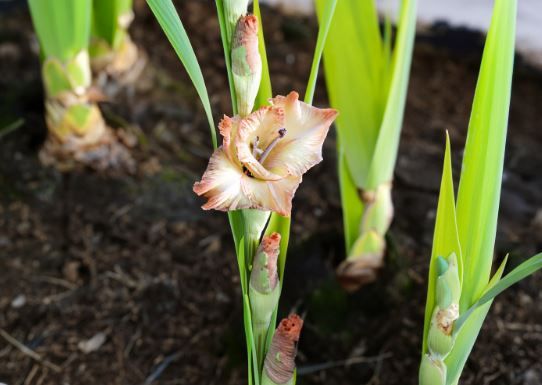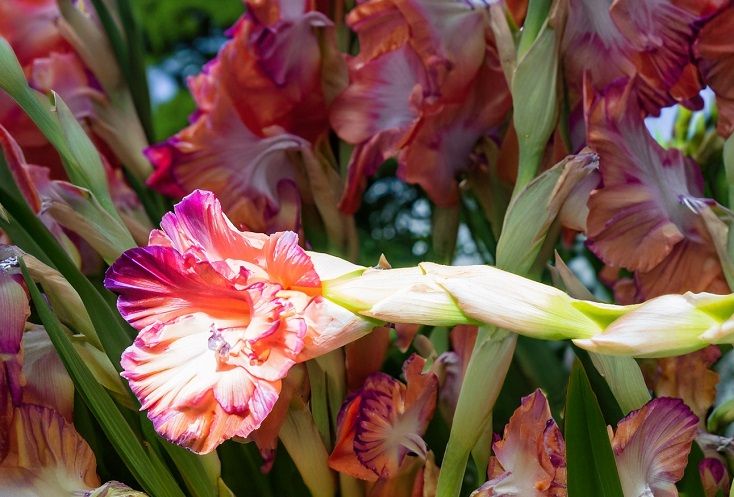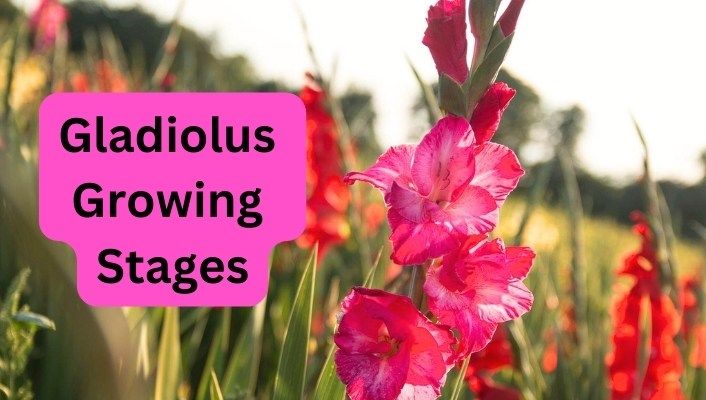There aren’t many flower plants as vibrant as Gladiolus. It’s tall spikes adorned with colorful flowers will add a touch of elegance to your flower arrangement. In order to grow this beautiful flowering plant successfully, you need to know all the Gladiolus growing stages.
Throughout this guide, you will learn about the various Gladiolus growth stages and some additional information for more care of the plant.
Post Contents
- Gladiolus: An Overview
- Benefits of Growing Gladiolus
- The 6 Gladiolus Growing Stages Explained:
- Common Issues and Troubleshooting
- Gladiolus Propagation Techniques
- Companion Planting with Gladiolus
- Gladiolus Flower Uses and Display Ideas
- FAQs
- What are the different stages of Gladiolus growth?
- What month do gladiolus come up?
- Do gladiolus only bloom once?
- What do you do with gladiolus after they bloom?
- When is the best time to plant Gladiolus bulbs?
- How deep should I plant Gladiolus bulbs?
- How long does it take for Gladiolus to bloom?
- How do I know when Gladiolus flowers are ready to be harvested?
- Can Gladiolus be propagated from seeds?
- Final Words
- Author
Gladiolus: An Overview
The Gladiolus is a family of iris plants that encompasses a variety of species and cultivars. It is scientifically known as Gladiolus spp. You can create stunning displays with these flowers because they come in a variety of colors, including vibrant reds, oranges, pinks, purples, and whites. In gardens and landscapes, gladiolus plants tend to reach a height of 2 to 6 feet.
The key to successfully growing Gladiolus is understanding their requirements. They require well-drained soil as well as full sun exposure to thrive. Regular watering and adequate spacing between bulbs are also essential.
Benefits of Growing Gladiolus
Aside from their sheer beauty, there are several reasons to consider growing Gladiolus in your garden. These include:
1. Aesthetic Appeal and Variety of Colors: Gladiolus flowers are renowned for their striking beauty. With their wide range of colors and attractive patterns, they can effortlessly enhance the visual appeal of any space.
2. Contribution to Garden or Landscape Design: With their tall spikes, Gladiolus creates an eye-catching focal point for garden beds and borders. They can be strategically placed to complement other plants and add depth to your landscape design.
3. Cut Flowers for Bouquets and Arrangements: Growing gladiolus will give you a supply of fresh-cut flowers to enjoy or share with others. Their long stems and vibrant blooms make them perfect for creating gorgeous bouquets and floral arrangements.
The 6 Gladiolus Growing Stages Explained:
To successfully grow Gladiolus, it’s crucial to understand their life cycle and the various stages they go through. Let’s delve into each stage in detail:
Stage 1: Germination
Growing gladiolus begins with their germination. As for sowing, gladiolus seeds should be planted in well-drained soil, ideally in early spring when the soil is warm. Gladiolus seeds should be sowing shallowly, about 1 inch deep.

In order for seeds to germinate successfully, they need adequate moisture and warmth. Most seeds germinate in only a few weeks, and the roots and shoots of the seeds begin to emerge in the following two weeks.
Stage 2: Vegetative Growth
In the vegetative phase of its growth, the gladiolus focuses on developing its foliage and building a solid root system. During this phase, the gladiolus creates several long, sword-shaped leaves arranged in a fan-like arrangement.
As a result, these leaves play a crucial role in the plant’s photosynthesis process, capturing sunlight and transmitting it to the plant for its growth. Proper sunlight, water, and a nutrient-rich soil are essential to the growth of healthy plants.
Stage 3: Bulb Formation
Bulb production occurs as the gladiolus plant continues its vegetative growth, and represents a specialized storage structure that stores nutrients to support the plant during dormancy periods and growth periods to come.

A gladiolus bulb forms at the base of the plant, just below the soil surface. As the bulb grows, it becomes larger and more rounded, and accumulates nutrients.
Stage 4: Flowering
Flowers of the gladiolus are vibrant and showy, making the flowering stage one of the most anticipated stages of growth. Depending on the variety and climate, flowering usually occurs in the summer or early autumn.
There are multiple, colorful flowers on a gladiolus stem, called an inflorescence. Their color, size, and shape vary with cultivar.
During their flowering period, gladiolus flowers range from vibrant red, orange, and yellow hues to soft pinks, purples, and whites. They provide a stunning display in gardens and as cut flowers.
Stage 5: Seed Production
During the flowering period of gladiolus, the flowers may produce seed pods. These seed pods contain the seeds, which can be collected for propagation. Ensure the seed pods are mature before removing them from the plant.
The pods can be harvested once they turn brown and dry out. Open the pods and collect the seeds for planting next year. As gladiolus hybrids are not always able to produce offspring with the same traits as the parent plant, it is important to note that growing gladiolus from seeds can result in variations from the parent plant.
Stage 6: Dormancy
Gladiolus plants enter dormancy after flowering and producing seeds. When temperatures drop during the colder months, the plant usually goes into dormancy. The above-ground growth dies back during this period, and the plant’s energy is transferred to the bulb to store energy.
A gladiolus bulb should be protected during dormancy by ensuring that the soil is not excessively moist and that it is insulated from frost. Gladiolus plants rest and conserve energy during the dormant period until favorable conditions return, resulting in a new growth cycle the following year.
Common Issues and Troubleshooting
While growing Gladiolus, you may encounter some challenges. Here are some common issues and solutions:
- Pest Infestations and Diseases: To manage pest infestations like thrips, aphids, or spider mites, use organic or chemical control methods. Make sure to treat diseases, such as fusarium wilt and botrytis blight, as soon as possible.
- Environmental Factors Affecting Growth: The Gladiolus prefers a warm climate with full sun exposure. Provide plants with at least 6 to 8 hours of sunlight daily. Maintain a healthy soil moisture and drainage. Protect plants from extreme temperatures, strong winds, and heavy rains.
Gladiolus Propagation Techniques
Gladiolus can be propagated through various methods:
1. Bulb Division: Every few years, dig up the bulbs and divide them into smaller sections, ensuring each division has a healthy bulb and foliage. Replant the divisions for new growth.
2. Cormels and Offsets: Cormels are small corms that develop alongside the main bulb. Carefully separate them and plant them separately to produce new plants. Offsets are miniature bulbs that form at the base of the main bulb. Detach them and plant them to propagate Gladiolus.
3. Seed Propagation: Harvest ripe seeds from Gladiolus flowers and sow them in well-drained soil indoors. Transplant the seedlings outdoors once they reach a suitable size.
Companion Planting with Gladiolus
You have several options when it comes to companion planting gladiolus. Consider the following companion plants:
1. Marigolds: When planted with Gladiolus, marigolds make for a vibrant and colorful display. Marigolds are also known as pest-repellent plants, so Gladiolus are protected against common garden pests when they are planted with marigolds.
2. Zinnias: A gladiolus and zinnia flower bed creates a visually pleasing and diverse appearance. A variety of color and shape make zinnias an excellent companion for gladiolus.
3. Dahlias: Both Gladiolus and Dahlia can work well together as they have similar growth habits and complement each other well. Dahlias also attract beneficial pollinators, which in turn benefit Gladiolus blooms.
These companion plants will enhance the beauty and functionality of your garden when planted alongside Gladiolus.
Gladiolus Flower Uses and Display Ideas
The versatility of Gladiolus extends beyond garden beds. Consider these uses and display ideas:
1. Floral Arrangements and Bouquets: Create stunning bouquets and floral arrangements by pairing Gladiolus with other compatible flowers. They are ideal for tall arrangements or for use as a centerpiece focal point because of their long stems.
2. Garden Design and Landscaping: Incorporate Gladiolus into your garden design to add vertical interest and vibrant colors. You can plant them in groups or rows to create an impressive visual effect.
3. DIY Crafts and Artistic Projects: Explore your creativity and make the most of these enchanting blooms by pressing gladiolus flowers for various artistic endeavors, such as cards, framed artwork, and botanical crafts.
FAQs
What are the different stages of Gladiolus growth?
There are different stages to Gladiolus growth, which include bulb selection and preparation, planting, germination, vegetative growth, flowering, and harvesting.
What month do gladiolus come up?
The gladiolus usually sprout in the spring or early summer, depending on the climate and planting time. You can usually see Gladiolus sprouting in May or June.
Do gladiolus only bloom once?
Gladiolus flowers bloom once during the growing season. However, each gladiolus spike produces multiple flowers that open sequentially from bottom to top, so it blooms longer.
What do you do with gladiolus after they bloom?
Whenever gladiolus bloom and fade, it’s important to deadhead them so the plant doesn’t get seedy and puts its energy into bulb growth. You’ll need to dig the bulbs up, dry them, and store them in a cool, dry place so they can be replanted next year. After that, let the foliage continue photosynthesis for a few weeks before cutting it back.
When is the best time to plant Gladiolus bulbs?
Gladiolus bulbs are best planted in late winter or early spring when the soil has warmed up and there’s no chance of frost.
How deep should I plant Gladiolus bulbs?
The depth of planting should be around 6 to 8 inches. Make sure to cover the bulbs with soil and water them thoroughly after planting. Mulching is also recommended to ensure they retain moisture.
How long does it take for Gladiolus to bloom?
Depending on factors like temperature, sunlight, and the variety of Gladiolus, it can take several weeks for Gladiolus to bloom. It is important to ensure that Gladiolus plants receive the necessary amount of sunlight, water, and nutrients to bloom in a timely manner. Additionally, it is important to ensure that the soil is well-drained to prevent the bulbs from rotting.
How do I know when Gladiolus flowers are ready to be harvested?
It’s best to harvest gladiolus flowers when one or two of the flowers on the spike have opened. This ensures the flowers have the longest vase life.
Can Gladiolus be propagated from seeds?
Yes, Gladiolus can be propagated from seeds. Sow mature seeds in well-drained soil after you harvest the flowers. After the seedlings get big enough, you can transplant them outside.
Final Words
A Gladiolus plant can be a rewarding experience when you have the chance to see the beauty of these magnificent flowers up close. You can grow healthy Gladiolus plants and enjoy an abundance of breathtaking blooms by following proper care practices and understanding the different stages of Gladiolus growth.
It’s time to roll up your sleeves, choose your favorite Gladiolus varieties, and create an awe-inspiring garden filled with these remarkable flowers.
Have fun!
Check out other flower related posts:

